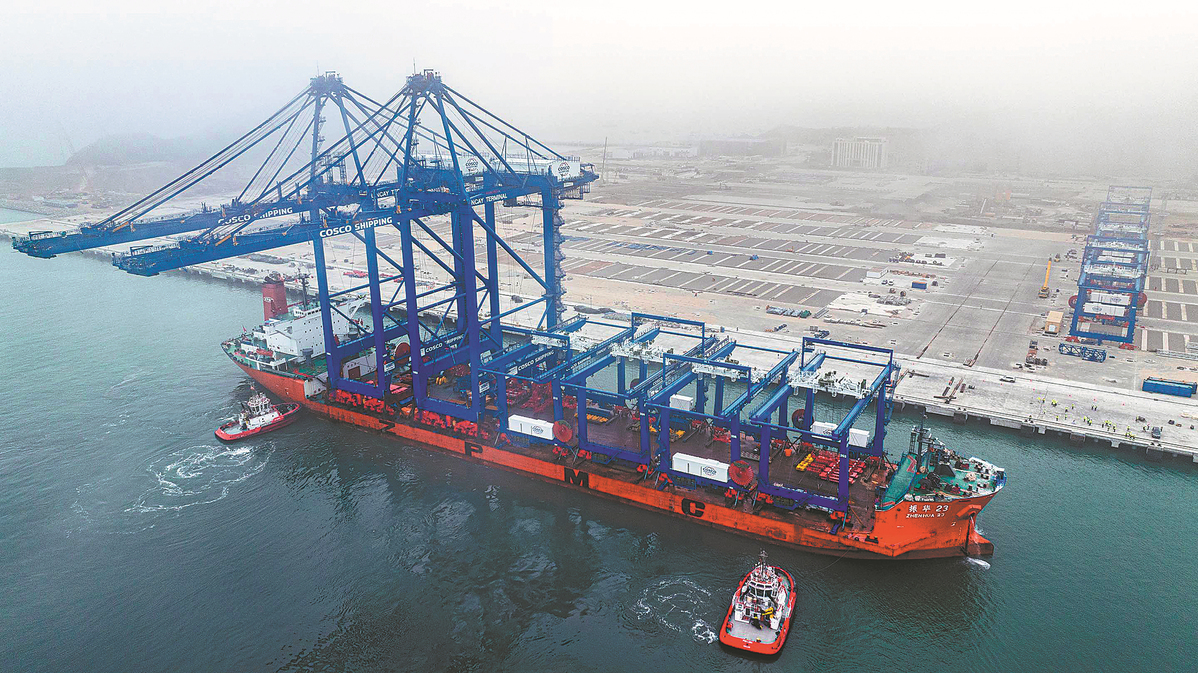
 0 Comment(s)
0 Comment(s) Print
Print E-mail China.org.cn, November 14, 2024
E-mail China.org.cn, November 14, 2024

Container cranes and rail-mounted gantry cranes shipped from China arrive on June 27 at the Chancay Port in Peru. [Photo/Xinhua]
The port of Chancay is located about 80 kilometers north of Lima, the capital of Peru, and borders the Pacific Ocean. The gigantic project, which began in 2021, is scheduled to begin trial operations later this month. The positive impact of the port on the global maritime transportation industry, its contribution to Peru and other South American countries, and the promotion of China's relations with Latin America cannot be underestimated.
First of all, Chancay Port is expected to become an important hub for global shipping. Some international media have referred to Chancay as the "Port of Singapore in Latin America" and "Latin America's Gateway Port to Asia."
These comments are not false. Many international shipping experts, geographers and economists believe that Chancay Port will change the existing pattern of freight logistics in Latin America with its advantages in fast turnaround, large throughput and high degree of modernization.
They also predict that the port will optimize the import and export trade channels of Latin America into Asian and global markets, and allow for goods from Peru and other countries in South America to leave the continent faster and more conveniently. It can be seen that it is not only China that will benefit, but also other Asian countries.
Second, Chancay Port is another landmark project created by the Belt and Road Initiative (BRI) in Latin America. Economic and trade relations are considered the "anchor" and "ballast stone" of China-Latin America relations.
As we all know, Latin America is a natural extension of the BRI. Before the completion of Chancay Port, the BRI had taken root and blossomed on the continent and yielded many successes. As a result, China's investment and trade in Latin America have increased significantly in recent years, with trade between the two sides on the verge of reaching an unprecedented $500 billion.
There is no doubt that the opening of Chancay Port will contribute significantly to the promotion of trade between China and Latin America, as goods from many South American countries will not have to be loaded from more distant Atlantic ports and then detoured through the Panama Canal or other shipping routes into the Pacific, nor will they have to be transported by road to Pacific ports. Such convenience is undoubtedly a real win-win.
Third, the port of Chancay has further strengthened relations between South America and Asia. The geographical location of the port determines its unique advantage in terms of its position facing the Pacific Ocean. As such, Chancay Port not only opens up a new channel between China and Latin America, but also serves the export trade of other South American countries.
Many goods from South America will be able to enter the Chinese market and the markets of other Asian countries more quickly in the future, thus making an important contribution to further promoting bilateral trade between Latin America and Asian countries.
Therefore, the port of Chancay is undoubtedly another miracle created by the BRI for Latin America. It is expected that Peru and other South American countries will see significant increases in exports to Japan, South Korea and ASEAN in the coming years.
Finally, the development of Chancay Port can also benefit the United States. In recent years, the U.S. has expressed growing concern over the rapid progress of Sino-Latin American relations. Illegal immigration and drug trafficking have historically been sources of tension between the U.S. and Latin American nations, often linked to the region's economic underdevelopment and poverty. However, China's multifaceted economic and trade cooperation with Latin American countries has yielded significant positive outcomes in terms of economic growth and poverty reduction.
Many studies by the World Bank, the Inter-American Development Bank and think tanks in Latin America have shown that without economic and trade relations between China and Latin America, the latter's economies would lose multiple percentage points in their growth rate. As people's living standards improve in Latin American nations, it is anticipated that illegal immigration and drug trafficking will decline, thereby mitigating some of the longstanding challenges between the U.S. and the region.
As such, rather than viewing China's economic presence in Latin America with apprehension, the U.S. should consider collaborating with China to jointly develop the Latin American market to foster a truly win-win scenario for all parties involved.
The author is a PhD candidate at the Center for Latin American Studies, Shanghai University.
Opinion articles reflect the views of their authors, not necessarily those of China.org.cn.
Go to Forum >>0 Comment(s)